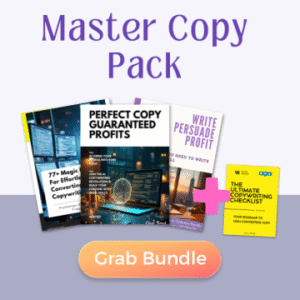In today’s digital marketing landscape, strong writing skills can set you apart. Finding the right course for copywriting can transform your career trajectory and boost your income potential. Whether you’re a complete beginner or looking to sharpen existing skills, the perfect copywriting course exists for your specific needs. Let’s explore how to find it and what you should expect from quality training.
What is copywriting and why take a course
Copywriting is the art of creating persuasive text that drives readers to take action. This specialized writing forms the backbone of marketing materials across all industries. From website content to email campaigns, social media posts to sales letters, effective copy powers business growth.
Many assume good writers automatically make good copywriters. This couldn’t be further from the truth. Copywriting follows specific principles and formulas that require proper training. A structured course for copywriting teaches these techniques systematically.
Taking a dedicated course offers several advantages over self-teaching:
- You learn proven frameworks instead of reinventing the wheel
- Instructors highlight common mistakes before you make them
- Feedback on your work accelerates improvement
- Structured curriculum ensures you don’t miss crucial concepts
- You gain insider knowledge about industry standards and expectations
Recommended reading:
- Copywriting email: persuasive marketing in your inbox
- Copywriting beginner 10 simple steps to Master the essential
- Top Books That Will Transform Your Copywriting Skills
Types of copywriting courses available
The copywriting education landscape offers diverse options to match different learning preferences and career goals. Understanding these categories helps narrow your search.
General copywriting foundations
These comprehensive programs cover core principles applicable across all copywriting formats. Students learn fundamental persuasion techniques, audience analysis, and basic copywriting formulas. Look for courses teaching the AIDA model (Attention, Interest, Desire, Action) and other essential frameworks.
Niche-specific training
Some courses focus exclusively on specialized areas:
- Direct response copywriting teaches high-conversion sales letters
- SEO copywriting combines search optimization with persuasive content
- Email copywriting focuses on sequences that nurture leads
- Technical copywriting addresses complex products and services
- UX copywriting centers on user experience and interface text
Industry-specific courses
Certain programs target writing for specific sectors:
- Financial services copywriting
- Health and wellness content
- Technology product marketing
- B2B versus B2C approaches
- E-commerce product descriptions
- Nonprofit fundraising copy
Format-based training
These courses drill down into mastering particular content types:
- Landing page optimization
- Social media copywriting
- Video script writing
- White paper creation
- Case study development
- Ad copywriting for different platforms
Key skills taught in quality copywriting courses
Effective copywriting courses should cover these essential competencies.
Research and audience analysis
Top courses teach you how to:
- Create detailed buyer personas
- Conduct customer interviews for insights
- Research competitor messaging strategies
- Identify pain points and desires
- Analyze successful copy in your niche
Psychology of persuasion
Quality programs explain psychological triggers like:
- Social proof implementation
- Scarcity and urgency techniques
- Reciprocity principles in marketing
- Authority positioning strategies
- Risk reversal approaches
Writing compelling headlines
Strong courses emphasize headline crafting through:
- Proven headline templates and swipe files
- A/B testing methodologies
- Emotional trigger incorporation
- Benefit-focused approaches
- Clarity and specificity techniques
Storytelling for business
Effective training covers narrative techniques including:
- Brand story development
- Customer journey mapping
- Problem-agitation-solution frameworks
- Character development in marketing
- Emotional arc creation
Call-to-action optimization
Learn to craft CTAs that convert through:
- Command language mastery
- Value proposition clarity
- Urgency creation
- Friction reduction techniques
- Testing and optimization methods
Editing and proofreading
Professional courses teach self-editing through:
- Concision training
- Readability improvement techniques
- Grammar and punctuation standards
- Style consistency maintenance
- Voice and tone adjustments
How to choose the right course for your needs
Finding the perfect course for copywriting requires careful consideration of several factors.
Experience level matching
Ensure the course matches your current skills:
- Beginner courses explain basic terminology
- Intermediate courses build on fundamental knowledge
- Advanced courses tackle complex strategies
- Master classes focus on specialized techniques
Learning style compatibility
Different courses utilize various teaching methods:
- Video-based lessons with demonstrations
- Text-heavy theoretical explanations
- Workshop-style practice sessions
- One-on-one coaching components
- Community learning environments
Career goal alignment
Select training that supports your professional aims:
- Agency preparation focuses on versatility
- Freelance courses include business development
- In-house roles require collaboration skills
- Entrepreneurial tracks emphasize sales copy
Instructor credentials
Evaluate the teacher’s qualifications:
- Professional experience writing profitable copy
- Teaching background and methodologies
- Client portfolio quality and diversity
- Published works and thought leadership
- Student success stories and testimonials
Curriculum comprehensiveness
Review course content for these elements:
- Real-world assignments mirroring client work
- Current industry practices and standards
- Software and tool training relevant to the field
- Portfolio development guidance
- Client acquisition strategies (for freelancers)
Online vs. in-person learning options
Both virtual and physical copywriting courses offer distinct advantages.
Online copywriting courses
Digital learning provides these benefits:
- Flexible scheduling for busy professionals
- Access to international instructors and perspectives
- Lower price points with fewer overhead costs
- Self-paced options for varied learning speeds
- Lifetime access to materials for future reference
However, consider these limitations:
- Less immediate feedback on your work
- Fewer networking opportunities with peers
- Limited accountability without scheduled sessions
- Requires strong self-discipline to complete
In-person copywriting workshops
Traditional classroom settings offer:
- Direct interaction with instructors for questions
- Peer networking for potential collaborations
- Structured schedule maintaining momentum
- Hands-on exercises with immediate guidance
- Distraction-free learning environment
Potential drawbacks include:
- Higher costs including travel expenses
- Fixed schedules requiring time commitment
- Limited geographic availability of quality programs
- Less diverse international perspective
Hybrid programs
Many courses now combine approaches with:
- Virtual learning modules for flexibility
- Live online sessions for direct feedback
- In-person meetups or workshops
- Community platforms for ongoing support
- One-on-one coaching calls for personalization
Cost considerations and investment returns
Pricing for copywriting education varies dramatically based on several factors.
Price ranges and what drives them
Copywriting courses typically fall into these brackets:
- Self-paced digital courses: $97-$997
- Group coaching programs: $1,000-$5,000
- Premium masterminds: $5,000-$15,000
- University certificate programs: $3,000-$12,000
- One-on-one mentorship: $2,000-$20,000+
Factors influencing price include:
- Instructor reputation and track record
- Course length and depth of material
- Access to personal feedback and reviews
- Community features and networking
- Bonus materials and resources
- Job placement assistance
Return on investment factors
Calculate potential ROI based on:
- Industry average rates for copywriters
- Your target market and niche
- Time to proficiency after course completion
- Networking opportunities within the program
- Portfolio pieces developed during training
- Client acquisition methods taught
Hidden costs to consider
Beyond tuition, budget for:
- Software subscriptions needed for coursework
- Reference books and swipe files
- Networking events and conferences
- Portfolio website development
- Additional coaching or feedback sessions
Learning paths: from beginner to advanced
Most copywriters follow a progression through different skills and specializations.
Foundational training
New copywriters should start with:
- Basic persuasive writing principles
- Understanding marketing fundamentals
- Grammar and style mastery
- Research methodology development
- Simple project management skills
Intermediate skill building
After basics, focus on:
- Niche specialization training
- Advanced formulas and frameworks
- Analytics and data interpretation
- A/B testing methodologies
- Client communication skills
Advanced mastery
Experienced copywriters should pursue:
- Conversion psychology depth study
- Strategic campaign development
- Cross-channel integration techniques
- Team leadership and direction
- Proprietary process development
Continuing education
Stay current through:
- Industry conference attendance
- Subscription to trade publications
- Masterminds with fellow professionals
- New platform adaptation training
- Emerging technology understanding
How to apply your new skills professionally
Completing a course for copywriting marks the beginning of your professional journey.
Building a compelling portfolio
Create work samples through:
- Course assignments repurposed as examples
- Pro bono projects for nonprofits
- Self-assigned spec work showing range
- Guest posting opportunities
- Personal brand content creation
Finding your first clients
Secure initial work through:
- Course instructor referrals and networks
- Freelance platforms with beginner opportunities
- Local business outreach with specific proposals
- Industry networking events
- Social media portfolio promotion
Setting appropriate rates
Develop pricing strategies based on:
- Project complexity and scope
- Research time requirements
- Revision rounds included
- Timeline expectations
- Usage rights transferred
- Your experience level
Delivering professional results
Meet client expectations through:
- Clear project briefs and questionnaires
- Regular communication checkpoints
- Organized revision processes
- Timely delivery commitments
- Measurement and reporting on outcomes
Scaling your copywriting business
Grow your practice by:
- Developing repeatable processes
- Creating packages for common requests
- Building referral systems with clients
- Establishing strategic partnerships
- Tracking and showcasing results
Success stories and outcomes
The right course for copywriting can dramatically change career trajectories.
Career switchers who found success
Many professionals transition successfully:
- Former teachers leverage explanation skills
- Journalists apply research abilities
- Lawyers utilize persuasive techniques
- Customer service reps understand buyer needs
- Technical experts translate complex topics
Freelance growth trajectories
Independent copywriters often follow this path:
- Side hustle while working full-time
- Part-time freelancing with steady clients
- Full-time practice with consistent workload
- Premium positioning with higher rates
- Agency model with subcontractors
In-house copywriting career paths
Corporate writers typically advance through:
- Junior copywriter handling simple projects
- Copywriter managing diverse assignments
- Senior copywriter directing strategy
- Copy chief overseeing team members
- Creative director shaping brand voice
Entrepreneurial applications
Business owners apply copywriting through:
- Launch campaign development
- Sales funnel optimization
- Content marketing strategy
- Brand messaging consistency
- Market positioning clarity
Evaluating course effectiveness
Measure your course’s value through these metrics.
Progress indicators
Track improvement via:
- Before and after sample comparisons
- Conversion rate increases
- Client feedback consistency
- Confidence level in tackling projects
- Speed of project completion
Certification value
Understand credential worth in:
- Client acquisition processes
- Agency hiring decisions
- Freelance platform rankings
- Professional networking contexts
- Setting appropriate service rates
Community benefits
Assess network value through:
- Peer feedback opportunities
- Collaboration possibilities
- Referral source development
- Accountability partnerships
- Industry insight sharing
Instructor accessibility
Evaluate teaching support via:
- Response time to questions
- Detail level in feedback
- Availability for follow-up
- Customization of guidance
- Ongoing relationship potential
Conclusion: Selecting your ideal copywriting course
Finding the perfect course for copywriting involves matching your specific needs with available options. Consider your learning style, career goals, budget constraints, and time availability when making this important decision. Remember that copywriting skills represent highly marketable abilities in today’s content-driven business landscape.
Begin by clarifying your objectives and researching thoroughly before committing. Many quality programs offer free introductory materials allowing you to experience their teaching style. Take advantage of these opportunities before investing in full courses.
The most successful copywriters combine formal training with consistent practice and real-world application. Your course provides the foundation, but your commitment to implementing what you learn ultimately determines your success.
Start your copywriting journey today by exploring the options outlined above. With dedication and the right training, you can develop skills that remain valuable throughout your entire career.

